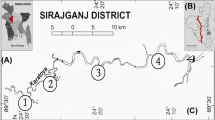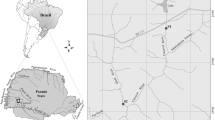Abstract
Influence of hydrological characteristics and nutrient concentrations on phytoplankton was investigated in four large rivers (Mura, Drava, Danube and Sava) in the Pannonian ecoregion in Croatia to understand how phytoplankton of rivers can be explained by the “different functional group approach”. To gain a clearer understanding of the factors that affect river phytoplankton, the present study examined phytoplankton biomass and composition in relationship with physical and chemical parameters assessed in detail by preparing self-organising maps using functional groups and morpho-functional groups. Total nitrogen along with water residence time showed to be the best predictor to determine phytoplankton biomass and chlorophyll a. Phytoplankton diversity increased with higher water discharge, but it had the consequence of diluting algae and decreasing biomass. Bacillariophyceae and Chlorophyceae species dominated the phytoplankton assemblages in all rivers. Diatoms predominated in rivers with shorter residence time. Dominant diatom codons of functional groups were C, D and TB while morpho-functional groups were represented by only diatom group VI. As residence time increased, the proportion of chlorococcalean green algae, represented by functional group codon T and morpho-functional group IV grew in summer. Since potamoplankton is dominated by diatoms, functional groups with its fine partition of diatom codons proved to be excellent descriptor of the potamoplankton. Application of morpho-functional groups originally developed from the lake data, showed to be limiting because of the predominating presence of only one diatom group.








Similar content being viewed by others
References
Abonyi, A., M. Leitão, A.-M. Lançon & J. Padisák, 2012. Phytoplankton functional groups as indicators of human impacts along the River Loire (France). Hydrobiologia. doi:10.1007/s10750-012-1130-0.
APHA, 2005. Standard Methods for the Examination of Water & Wastewater. American Public Health Association, Washington.
Baker, A. L. & K. K. Baker, 1979. Effects of temperature and current discharge on the concentration and photosynthetic activity of the phytoplankton in the upper Mississippi River. Freshwater Biology 9(3): 191–198.
Borics, G., G. Várbíró, I. Grigorszky, E. Krasznai, S. Szabó & K. T. Kiss, 2007. A new evaluation technique of potamo-plankton for the assessment of the ecological status of rivers. Large Rivers 17(3–4): 465–486.
Carvajal-Chitty, H., 1993. Some notes about the Intermediate Disturbance Hypothesis and its effects on the phytoplankton of the middle Orinoco river. Hydrobiologia 249(1): 117–124.
Céréghino, R. & Y. S. Park, 2009. Review of the self-organizing map (SOM) approach in water resources: commentary. Environmental Modelling & Software 24(8): 945–947.
Clarke, K. R. & R. N. Gorley, 2006. PRIMER v6: User Manual/Tutorial. PRIMER-E, Plymouth.
Descy, J. P., 1993. Ecology of the phytoplankton of the River Moselle: effects of disturbances on community structure and diversity. Hydrobiologia 249(1): 111–116.
Devercelli, M., 2006. Phytoplankton of the Middle Paraná River during an anomalous hydrological period: a morphological and functional approach. Hydrobiologia 563(1): 465–478.
Dodds, W. K., 2006. Eutrophication and trophic state in rivers and streams. Limnology and Oceanography 51(1, part 2): 671–680.
Dodds, W. K. & J. Cole, 2007. Expanding the concept of trophic state in aquatic ecosystems: it’s not just the autotrophs. Aquatic Sciences – Research Across Boundaries 69(4): 427–439.
Gosselain, V., S. Campeau, M. Gevrey, M. Coste, L. Ector, F. Rimet, J. Tison, F. Delmas, Y. Park, S. Lek & J. P. Descy, 2005. Diatom typology of low-impacted conditions at a multi-regional scale: combined results of multivariate analyses and SOM. In Lek, S., M. Scardi, P. Verdonschot, J.-P. Descy & Y.-S. Park (eds), Modelling Community Structure in Freshwater Ecosystems. Springer, Berlin: 317–342.
Kelly, M., A. Cazaubon, E. Coring, A. Dell’Uomo, L. Ector, B. Goldsmith, H. Guasch, J. Hürlimann, A. Jarlman, B. Kawecka, J. Kwandrans, R. Laugaste, E. A. Lindstrøm, M. Leitao, P. Marvan, J. Padisák, E. Pipp, J. Prygiel, E. Rott, S. Sabater, H. van Dam & J. Vizinet, 1998. Recommendations for the routine sampling of diatoms for water quality assessments in Europe. Journal of Applied Phycology 10(2): 215–224.
Kiss, K. T., 1997. Short and long-term changes of the phytoplankton in the Hungarian section of Danube river. Doctorate thesis. University of Debrecen, Hungary.
Kiss, K. T. & S. I. Genkal, 1996. Phytoplankton of the Danube’s reservoirs in September 1995 from Germany to Hungary. Limnologische Berichte Donau 1: 143–148.
Kiss, K. T. & A. Schmidt, 1998. Changes if the Chlorophyta species in the phytoplankton of the Hungarian section of the Danube river during the last decades (1961–1997). Biologia Bratislava 53: 509–518.
Kiss, K. T., A. Schmidt & É. Ács, 1996. Sampling strategies for phytoplankton investigations in a large river (River Danube, Hungary). In Whitton, B. A., E. Rott & G. Friedrich (eds), Use of Algae for Monitoring Rivers II. Universität Innsbruck, Institut für Botanik: 179–185.
Kohonen, T., 2001. Self-organizing Maps. Springer, Berlin.
Kruk, C., V. L. M. Huszar, E. T. H. M. Peeters, S. Bonilla, L. M. Costa, C. Lürling, S. Reynolds & M. Scheffer, 2010. A morphological classification capturing functional variation in phytoplankton. Freshwater Biology 55(3): 614–627.
Leopold, L. B., M. G. Wolman & J. P. Miller, 1995. Fluvial Processes in Geomorphology. Dover Publications, Mineola, NY.
Lund, J. W. G., C. Kipling & E. D. Cren, 1958. The inverted microscope method of estimating algal numbers and the statistical basis of estimations by counting. Hydrobiologia 11(2): 143–170.
Padisák, J., C. S. Reynolds & U. Sommer, U., 1993. Intermediate disturbance hypothesis in phytoplankton ecology: proceedings of the 8th workshop of the International Association of Phytoplankton Taxonomy and Ecology held in Baja (Hungary), 5–15 July 1991. Kluwer Academic Publishers, Dordrecht.
Padisák, J., L. Crossetti & L. Naselli-Flores, 2009. Use and misuse in the application of the phytoplankton functional classification: a critical review with updates. Hydrobiologia 621(1): 1–19.
Phillips, G., O. P. Pietiläinen, L. Carvalho, A. Solimini, A. Lyche Solheim & A. Cardoso, 2008. Chlorophyll–nutrient relationships of different lake types using a large European dataset. Aquatic Ecology 42(2): 213–226.
Pieterse, A. & J. van Zyl, 1988. Observations on the relation between phytoplankton diversity and environmental factors in the Vaal River at Balkfontein, South Africa. Hydrobiologia 169(2): 199–207.
Reynolds, C., 1988. Functional morphology and the adaptive strategies of freshwater phytoplankton. In Sandgren, C. D. (ed.), Growth and Reproductive Strategies of Freshwater Phytoplankton. Cambridge University Press, Cambridge: 388–433.
Reynolds, C. S., J. P. Descy & J. Padisák, 1994. Are phytoplankton dynamics in rivers so different from those in shallow lakes? Hydrobiologia 289(1): 1–7.
Reynolds, C. S., V. Huszar, C. Kruk, L. Naselli-Flores & S. Melo, 2002. Towards a functional classification of the freshwater phytoplankton. Journal of Plankton Research 24(5): 417–428.
Rimet, F., L. Ector, H. M. Cauchie & L. Hoffmann, 2004. Regional distribution of diatom assemblages in the headwater streams of Luxembourg. Hydrobiologia 520(1): 105–117.
Rott, E., 1981. Some results from phytoplankton counting intercalibrations. Aquatic Sciences – Research Across Boundaries 43(1): 34–62.
Salmaso, N. & M. Braioni, 2008. Factors controlling the seasonal development and distribution of the phytoplankton community in the lowland course of a large river in Northern Italy (River Adige). Aquatic Ecology 42(4): 533–545.
Salmaso, N. & A. Zignin, 2010. At the extreme of physical gradients: phytoplankton in highly flushed, large rivers. Hydrobiologia 639(1): 21–36.
Schmidt, A., 1994. Main characteristics of the phytoplankton of the Southern Hungarian section of the River Danube. Hydrobiologia 289(1): 97–108.
Shannon, C. E. & W. Weaver, 1963. The Mathematical Theory of Communication. University of Illinois Press, Urbana, IL.
Soballe, D. M. & B. L. Kimmel, 1987. A large-scale comparison of factors influencing phytoplankton abundance in rivers, lakes, and impoundments. Ecology 68(6): 1943–1954.
Stevenson, R. J. & Y. Pan, 1999. Assessing environmental conditions in rivers and streams with diatoms. In Stoermer, E. F. & J. P. Smol (eds), The Diatoms: Applications for the Environmental and Earth Sciences. Cambridge University Press, Cambridge: 11–40.
Thorp, J. H., M. D. Delong, K. S. Greenwood & A. F. Casper, 1998. Isotopic analysis of three food web theories in constricted and floodplain regions of a large river. Oecologia 117(4): 551–563.
Uherkovich, G., 1971. A Tisza lebegőparánynővényei (A Tisza fitoszesztonja) (Phytoseston of the Tisza). Szolonok Megyei Muze umi adattar Szolonok.
Utermöhl, H., 1958. Zur Vervollcommung der Quantitiven Phytoplankton Methodik. Verhandlungen der Internationalen Vereinigung für Theoretische und Angewandte Limnologie 9: 1–38.
Van Dam, H., A. Mertens & J. Sinkeldam, 1994. A coded checklist and ecological indicator values of freshwater diatoms from The Netherlands. Aquatic Ecology 28(1): 117–133.
Van Nieuwenhuyse, E. E. & J. R. Jones, 1996. Phosphorus chlorophyll relationship in temperate streams and its variation with stream catchment area. Canadian Journal of Fisheries and Aquatic Sciences 53(1): 99–105.
Vannote, R. L., G. W. Minshall, K. W. Cummins, J. R. Sedell & C. E. Cushing, 1980. The river continuum concept. Canadian Journal of Fisheries and Aquatic Sciences 37(1): 130–137.
Várbíró, G., G. Borics, K. T. Kiss, K. E. Szabo, A. Plenkovic-Moraj & É. Ács, 2007. Use of Kohonen Self Organizing Maps (SOM) for the characterization of benthic diatom associations of the River Danube and its tributaries. Large Rivers 17(3–4): 395–403.
Vollenweider, R. A. & J. J. Kerekes, 1982. Eutrophication of Waters: Monitoring, Assessment and Control. Organisation for Economic Co-operation and Development, Paris.
Wehr, J. D. & J.-P. Descy, 1998. Use of phytoplankton in large river management. Journal of Phycology 34(5): 741–749.
Wetzel, R. G., 2001. Limnology: Lake and River Ecosystems. Academic Press, San Diego.
Wetzel, R. G. & G. E. Likens, 2000. Limnological Analyses. Springer, Berlin.
WFD, 2000. Directive 2000/60/ec of the European Parliament and of the Council 22.12.2000. Official Journal of the European Communities L327: 1–72.
Acknowledgments
We thank our colleagues from the Central Water Management Laboratory, particularly the Head of the Lab Marija Marijanović Rajčić for constant support and help in the field sampling and chemistry sample analysis, and Antonija Žižić for every day help in diatom identification. This manuscript has been greatly improved by the comments of Vlatka Mičetić Stanković, University of Zagreb and by Debarshi Dey. We also thank to two unknown reviewers for making this manuscript better with their detailed comments and suggestions. Special thanks to Luciane Crossetti (Green Guru) for her constant expert and friendly support in work, and to the Organising committee and participants of the 16th IAP for support and encouragement for publishing our data. We thank to the National Meteorological and Hydrological Service for providing the hydrological data. The investigation was supported by Hrvatske vode.
Author information
Authors and Affiliations
Corresponding author
Additional information
Guest editors: N. Salmaso, L. Naselli-Flores, L. Cerasino, G. Flaim, M. Tolotti & J. Padisák / Phytoplankton responses to human impacts at different scales: 16th workshop of the International Association of Phytoplankton Taxonomy and Ecology (IAP)
Rights and permissions
About this article
Cite this article
Stanković, I., Vlahović, T., Gligora Udovič, M. et al. Phytoplankton functional and morpho-functional approach in large floodplain rivers. Hydrobiologia 698, 217–231 (2012). https://doi.org/10.1007/s10750-012-1148-3
Received:
Accepted:
Published:
Issue Date:
DOI: https://doi.org/10.1007/s10750-012-1148-3




